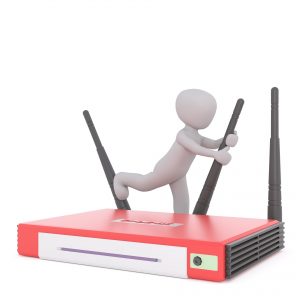
Have you noticed how important the wifi connection in your house has become? With the rise of mobile devices and the Internet of Things (IOT), your home wifi is more important than ever. Cell phones, streaming devices, smart bulbs, home security systems, washers and dryers, smart speakers, TVs, and so many other gadgets now require wifi connections in order to access all the geeked out features that caused you to buy them in the first place.
Now that you’ve developed this major reliance on your wifi you need to make it fast, secure and stable. We are going to talk about the 3 major problems with your home wifi (some you may not even know you have) and more importantly, we will detail ways to diagnose and fix these problems.
Before we get started, let’s define a few terms so we are all on the same page:
- IOT – Internet of Things. This refers to all the connected devices in our homes other than typical PCs and smart phones.
- Access point – AP. A device that allows other devices to connect to a network. In this article, we are primarily referring to wireless access points, which allow wireless devices to connect to your network
- Router. A network device that controls the traffic out of, into, and inside your home. Usually coupled with a wireless access point. For most of this article, I will use the terms access point and router interchangeably, although they are not strictly the same.
- QOS – Quality of Service. This refers to settings on your router that allow for the control of priority and treatment of different types of traffic (streaming, web browsing, torrenting) on your network.
Table of Contents
Major Problem #1: Your wifi is too slow

Is your wifi slow? Do you sometimes find yourself waiting a long time for your app to load, or an attachment to download, or a for a web page to come up on your mobile phone? Does your favorite streamed shows buffer and/or stream at lower than HD quality? We have the tips and tricks that will make your wifi speed problems a thing of the past!
The root cause of your wifi slowdown can be hard to find. We are going to start with how to diagnose the major culprits and then apply a fix!
Wifi Speed Culprit #1: Your Internet connection is really slow
Symptoms:
- You don’t pay much for your Internet service.
- You and your family use a lot of bandwidth.
- You haven’t properly configured your router’s QOS settings.
Diagnosis:
- First, find out what bandwidth you have. Go to speedtest.net from a wired computer on your home network and test your Internet speed a few times and different points in the day. Make sure no other devices are doing any significant downloading or uploading to the Internet (streaming videos, downloading large files, etc.) at the same time. Are they the speeds you are expecting based on the package you purchased from your Internet Service Provider (ISP)?
- What speed did you pay for? Do you know how much speed you need? For example, Netflix recommends 5Mbps for each high-quality HD Stream and 25Mbps for each Ultra HD stream. Below are some common bandwidth needs for home network activities:
- HD Video streaming: 5-25Mbps per stream (downloading)
- Music streaming: < 1Mbps per song (downloading)
- Online Gaming: 3-6Mbps download/1-3Mbps upload per person
- Web/Social Media: 3Mbps download/1.5Mbps upload per person
- HD Video Call (e.g Skype): 1-4Mbps upload/download per person
The amount of bandwidth your home needs depends on the number of people and their regular usage of the Internet at home. For example, let’s say it’s common in your home for a couple of people to be streaming a video (~15Mbps), a couple more to be browsing the web/social media (~6Mbps) while someone is gaming online (~6Mbps) and streaming music in the background (~1Mbps). 15+6+6+1 adds up to 28Mpbs which would be the minimum download bandwidth needed to support these activities. You should always add at least 30% overhead to your calculated minimum. The speeds ISPs quote are max figures and not always available. Often there are other devices on the network that are steadily using small amounts of Internet bandwidth (e.g. checking for and downloading updates). Keep in mind that if you are frequently viewing and or sending videos, pictures, and other files via social media your needs may be higher than the average 3Mbps figure above. Also, there are often spikes in the rates needed by these services. For example, an online game may average needed 3Mbps but may have certain spikes where it needs 10Mbps to function properly. In the example I gave earlier I’d recommend you actually get around 40Mbps to cover your needs.
If you are constantly downloading content (via torrents and/or Usenet, for example) then you already know you have high bandwidth needs. It will come down to how fast you want those downloads to happen and how often you download.
- Have you looked at your router’s quality of service (QOS) settings? These settings can determine which types of Internet traffic and which devices have priority so that you can use your Internet bandwidth efficiently. For instance, you might want to prioritize streaming video and video chats over torrent downloads and web surfing because you hate it when your video degrades or buffers and you would like to keep the quality of video high at the expense of slowing down a web page load or file download. These are the types of scenarios you may be able to configure with your router’s QOS settings.
After walking through the steps to test your Internet speed and estimate your needs do you find you have a fast enough Internet connection? If not, this could be a major reason your wifi seems slow. You must have enough bandwidth for all the devices (not just wireless) that access the Internet. If you don’t it is time to upgrade your connection with your ISP (or another ISP). You also want to make sure you have modified your router’s QOS settings to prioritize the Internet traffic that is most important to you.
Wifi Speed Culprit #2: Other devices are hogging your wifi bandwidth
Symptoms:
- There is a lot of wifi traffic going across your Local Area Network (LAN).
- Somebody is on your wifi network you don’t know about…
Diagnosis:
- Do you have a NAS? If you do chances are you have backups going on in your network, are streaming music, pictures and videos wirelessly on your network using something like Kodi, Plex, or MythTV. These will hog a lot of bandwidth on your wifi.
- Do you run some type of networked home surveillance system or do you have some wireless cameras in your home? Having these on your network can take up as much bandwidth as streaming Netflix.
- Have you run security checks and malware scans on the devices on your network? If not you could have malware that is sniffing across your network doing nefarious things. In addition to compromising your devices and data, this can slow down your network!
Can you identify every device that is connected to your network? You want to make sure you don’t have your neighbors connecting to your network and using up your bandwidth.
Think about the diagnosis items. Make sure you know what is going on in your network and what the impacts may be. If you have items on your network constantly sending traffic (like video cameras) try to make them wired devices instead of wireless. Wireless may be convenient but if there is an option for a wired connection you should take it and reserve the wireless bandwidth for mobile devices and others that are hard to give wired connections.
Go to your router and/or access point settings and see if you can tell which devices are connected to your wireless network, and what bandwidth they are using. Many routers and access points have traffic charts to detail network activity,
I’ll talk more about detecting and preventing malware and unwanted users on your network in the security section of this article.
Wifi Speed Culprit #3: Some of your wireless devices are really old
Symptoms:
- You still have wireless G devices on your network.
- Your devices don’t support the 5Gghz protocols.
Diagnosis:
- What protocols do your mobile devices support? If you have a lot of devices that only support 2.4ghz protocols (802.11g and 802.11n 2.4Ghz) your speeds are limited, and your wifi is subject to more interference than the 5Ghz protocols. Moreover, you may be forced into running your wireless router/AP in a mode that restricts the wifi speed of all devices that connect to it just to support the older devices.
- What protocols does wireless router/AP support? Does it have multiple radios capable of separating the protocols so that it doesn’t need to run in a “mixed-mode” that slows down speed for the faster devices?
- How long has it been since you upgraded your router/AP? Your router may be too old to support the newer protocols your mobile devices are capable of using. The age of your router/AP also has security implications (more on that later…).
If you have a lot of older devices on your network and you have to support older wireless protocols you are probably slowing down your network speeds. You might consider upgrading your router/AP to one that can support older and newer protocols without slowing down the faster devices or upgrading or replacing your older wifi devices. Check out my Buyer’s Guide for new router recommendations. Make sure to take the wireless protocol support of a device into consideration when making a purchasing decision, both for your router and your client devices.
Wifi Speed Culprit #4: Your wifi signal is weak
This is a common cause of slow wifi speeds. We will talk more about signal strength and stability later in this article.
Major Problem #2: Your wifi security is lacking

One of the easiest ways to hack into a home network is to attack through its wifi network. Have you taken steps to secure your wifi? Many pages of text could be devoted to ways to secure your wifi. I’ll try to focus on actionable important ones that will keep you covered against most vulnerabilities.
Wifi Security Culprit #1: Your router is too old
Symptoms:
- New firmware for your router hasn’t been released in years.
- Your router doesn’t support dual-band wireless.
- You don’t get the Internet speeds you think you should get from your ISP.
- You have to reboot your router somewhat frequently to keep it working properly.
Diagnosis:
- Is your router more than 5 years old? Check to see what the latest firmware release is for your router. If it has been a few years your router may not be able to provide adequate and up to date security.
- Does your router support 5Ghz protocols like N and AC? If it doesn’t it may be too old.
- Did you run the speed tests mentioned earlier? Were your speeds significantly lower than the package you bought from your ISP? There could be a few reasons for this, but one reason might be that your router is too old to provide the speed that you are paying for.
- Do you have to reboot your router regularly for it to keep functioning?
If your router is running on old software it won’t have the latest security protections. Make sure and check for newer firmware for your router. If your router is outdated consider upgrading your router to properly protect your network and possibly give you faster wifi speeds and more capabilities. How to choose a router is a topic for another article.
Wifi Security Culprit #2: You haven’t changed the default settings on your router
Symptoms:
- Your router login username and password are something like “admin” and “password.”
- The name of your wifi network (SSID) includes the brand of the router.
- Your router’s firewall isn’t enabled.
- You are not using WPA2 security.
- You router admin interface is accessible on the Internet.
Diagnosis:
- Log in to your router (was the username/password “admin”/”password”?). Check to make sure that your firewall is enabled, you are using WPA2 security on your wifi and that you have a nondefault name for your wifi network. Find the setting to disable remote access (access from the Internet) to your router.
There are many more steps to properly secure your router, but if you take care of these your wifi network will be much more secure. Leaving settings at the defaults allows hackers to more easily compromise your home network. Many hackers target specific brands of routers and leaving the brand in your wifi SSID signals to hackers the brand of your router as well as that it may have other default settings they can exploit.
Wifi Security Culprit #3: You don’t have a guest network
Symptom and diagnosis:
The symptom and diagnosis here are simple. You never set up a guest wifi network and/or your router/AP doesn’t have that functionality.
If you don’t have a guest network, you may find yourself in a situation where you have guests over and you have to give them your password so they can access your network. This gives your guests not only your password, which may be sensitive and used for different accounts (shame on you 🙂 ), but also access to all of your networked devices (printers, network shares, PCs, etc.). Sure, you probably trust the people who have your password, but do you completely trust that all the software and apps they use are free of malware that can compromise the devices on your network? You shouldn’t. A proper guest network allows you to set a separate and shareable password for your guests and firewalls off your private computer resources from being compromised by guests. Many routers and APs have this feature. If yours does it is worth learning how to configure it. If not, consider purchasing a router or AP that has the feature.
Wifi Security Culprit #4: You have not segregated your IOT devices from the rest of your network
Symptom and diagnosis:
The symptom and diagnosis are simple here as well. If your IOT devices are running on the same wifi network as all of your other devices they probably have access to the rest of your network. Unless you’ve done something explicitly to limit their access (VLAN, access control lists, a separate IOT wifi network) they are probably members of your network like any other device.
You may be asking why IOT devices need to be segregated from the rest of the network. The answer is that IOT devices have been hacked en masse. Lightbulbs, switches, thermostats, refrigerators, network cameras and many more IOT devices have been hacked. Some have been compromised to attack other people and companies, some have been used to attack the device owners. IOT devices have revealed owner wifi passwords.
IOT devices are not known for having the best security features, and they are usually always connected and accessible from the Internet. Once these devices are compromised they can be used to probe and attack other devices on your network. Sensitive personal information stored on your computer could be compromised. This is why you want to protect the rest of your network from these devices.
Segregating your IOT devices can be a complicated affair. Some ways of doing it involve modifying routing tables and setting up separate subnets. But nowadays newer routers and access points have features where you can set up a network just for these types of devices that secure them from your other network devices. This works very similarly to a guest network. You just end up putting your IOT devices on a separate network. When you are looking for a new router or AP make sure and look for this function. Yes – we live in a world where we need to protect ourselves from lightbulbs and thermostats!
As an aside, I have spent a lot of time segregating my network as I have a lot of smart devices. I used ACLs and firewall rules to accomplish my goal. Mine is a bit more complicated because there are sets of devices I want to be able to access the IOT devices and I want the IOT devices to have access to them, but not all non–IOT devices. Like I said, it’s complicated. Here are some more tips to improve your home network security.
Major Problem #3: Your wifi signal is not stable throughout your home
Wifi Stability Culprit #1: Your router is your wireless AP
Symptoms and diagnosis:
Most routers also have wireless AP capabilities. This can be a cost-effective way, especially for smaller homes that only need one wireless AP, to provide coverage for the entire house. However, lack of flexibility with where you can place the router can be a problem. For most homes, the ideal place to put a single wireless AP is somewhere near the middle of your home high up on a wall or on the ceiling. This spot is usually not an option for most homes because routers need to be near the modem provided by the ISP, which is often in a room nowhere near the middle of the house. Also, many people have a modem provided by the ISP that also functions as the router and AP, further constraining its placement.
If you can’t place the router in a good spot in your home, or you have a larger home that a single router can’t cover then you will have spots in your home that aren’t covered or have poor wireless performance. You can fix this by buying a wifi range extender, a wireless access point, or by replacing your router with mesh system. Let’s take a quick look at these options.
A range extender, such as the TP-Link AC1759 Wi-Fi Range Extender, simply rebroadcasts your wireless signal to other parts of your home, thereby extending your wireless coverage range. Some have extra features like providing an ethernet connection and providing a guest network. The downside of range extenders is that there will be some speed loss, but some wifi extenders greatly reduce this loss by using multiple radios (separating the signal the duties of receiving and transmitting the signal) and faster processors. Look for a range extender with these features.
A wireless access point, like the TP-Link EAP 225 (see my review here), plugs into a wired port somewhere in your home and can broadcast a wireless signal from there. Unlike range extenders, there is no wireless speed loss because they aren’t rebroadcasting a signal. The downside, when compared to wifi range extenders, is that they need access to an ethernet connection to work. Many also have features like guest networks and traffic monitoring. If you have access to a wired connection in an ideal spot in your home this is my recommended option. If you have a really large home you can use multiple access points.
Mesh wifi systems, like the Netgear Orbi or Google Wifi, have become really popular. You can think of them as multiple easy to setup range extenders that are made to work together. Most systems give advice and tools on how to place them to get full coverage for your home. One key piece of information to know is that mesh systems are also designed to replace your router. This means they come with tons of features that wifi extenders will not have. If you don’t want to or can’t replace your router then mesh systems aren’t for you (unless you want to get into the complications of running multiple routers on your network, or you get a mesh system that can work in bridge mode). This is the most expensive of the three options. If you have a large home that doesn’t have wired networking throughout the house this is probably your best option.
If you are looking into buying a range extender, access point, or mesh system be sure to check out my Buyer’s Guide for recommendations.
Wifi Stability Culprit #2: You have too many wifi devices on your network
Symptoms and diagnosis:
Diagnosing whether or not you have too many wifi devices on your network can be difficult. The issue I am diagnosing here is different than too many devices hogging your LAN bandwidth or Internet bandwidth that I wrote about earlier. Theoretically, most wireless access points can have 255 devices connected at a time, but that doesn’t mean they’ll work well with that many. You probably won’t find the maximum limit in your access point’s documentation. If you only have one access point I’d start to worry about having too many wifi devices when you get to around 20-25 devices connected at a time. At this point, depending on how active those devices are, you may also start to run into bandwidth issues. We mentioned how to solve the bandwidth issue earlier, but if you believe you have fixed your bandwidth issues and you are still experiencing slowness you may want to upgrade your access point or add an access point to distribute the load of your wireless devices.
Some of you are thinking that you’ll never get to 20-25 wireless devices. It can happen faster than you think. Smartphones, tablets, streaming sticks, video game consoles, smart TVs, smart hubs, smart bulbs, thermostats, smart plugs, smart refrigerators, smart toothbrushes, smart scales, smart watches, smart smoke detectors, smart washers, and dryers… I think you get my point. More and more wifi enabled devices are entering your home.
Wifi Stability Culprit #3: You aren’t using the best wifi protocols
Symptoms:
- You only have 2.4Ghz wireless.
- You don’t have wireless AC.
- You have AC or 5Ghz wireless N but your client devices don’t use them.
Diagnosis:
- Go check the wireless settings on your router. Do you have 5Ghz N available? Do you have wireless AC available? Are any of your devices connecting to the 5Ghz protocols?
2.4GHz wifi (both G and N) can be very unstable in today’s world. Those protocols can have a lot of interference from other devices (like microwaves, phones, security systems and baby monitors) and from other neighbors running 2.4Ghz wireless networks. This interference can cause speed slowdowns and even drops in your wifi connection. The 5Ghz protocols are much more resistant to interference. They are also faster. The downside is that they don’t cover as much area as the 2.4Ghz protocols, and fewer clients support them. My suggestion would be to avoid buying devices that don’t support 5Ghz protocols if possible from here going forward.
Final Words
Stable and fast wifi is a critical component of your home technology infrastructure. Few things are more frustrating than constantly buffering Netflix streams and slow mobile browsing. An insecure home network can lead to disastrous consequences. Hopefully, I’ve provided you with tips on how to diagnose and improve your wifi speed, security, and stability.
What wifi problems are you having? What solutions have you come up with? Are you using any of the products or tips above? I would love to discuss it! Please leave a comment with your wifi challenges and solutions.
Editor’s Note: This page contains affiliate links. I receive a commission if you purchase a product through one of my affiliate links, at no cost to you. For more information read my disclosures.


